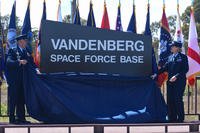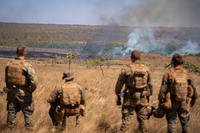SOUTHWESTERN AFGHANISTAN – When 26th Expeditionary Rescue Squadron HH-60G Pave Hawk helicopters scramble for a casualty evacuation mission, the environment they are flying into is unpredictable.
Whether the environment is hostile or not, they always prepare for the worst -- that's where Air Force Senior Airman Austin Stoker comes in. The munitions systems specialist ensures the crews have the resources to fight if they have to.
"You have to be able to go into a combat area where people are dying and pull them out, and you need firepower to do it," Stoker said. "Without it, there is no rescue and the crew isn't coming back."
Deployed from the California National Guard's 129th Rescue Wing, Moffett Federal Airfield, Calif., Stoker and the 26th ERQS aircrew, maintenance and support teams augment a highly visible and important medical evacuation mission in Regional Command Southwest.
Air Force pararescue members, combat rescue officers, crew chiefs and gunners scramble when they get word that a coalition servicemember is injured and needs lifesaving assistance.
Air Force Lt. Col. George Dona, 26th ERQS commander, said without all the parts of the mission working, "the crews can't fly, the helicopters won't work, and the guns won't shoot.”
“I need all of this to come together,” he added, “and I need it to come together on a moment's notice."
Dona said that so far, the support teams have delivered.
"They have more than just met the challenge -- they have far exceeded the expectations that I had for the squadron," he said.
Stoker's role in the mission is important in ensuring the crews can defend themselves with the ammunition he maintains and provides.
"Our mission is to provide munitions support, from the smallest rounds to grenades, [including .50-caliber machine guns] and countermeasure flares used to keep the aircraft from being shot out of the skies," the Stockton, Calif., native said.
Countermeasure flares help prevent projectiles from hitting the aircraft. Stoker said successful countermeasures sometimes are the only thing that ensures a crew makes it back from a rescue mission.
His daily duties include maintenance on ammunition systems, weapons compatibility checks, and inventory on stockpiles and expended rounds.
Stoker said maintaining an inventory is a large part of his job because the Air Force tracks 100 percent of its ammo.
"Every bullet is accounted for," he said. "If you shoot a bullet, you better have a reason."
After transitioning from active duty service to the Guard in 2011, Stoker said, he joined the 129th Rescue Wing with hopes to deploy more often.
Stoker said he has a strong respect for the rescue mission here, and for his coworkers.
"The pararescue mission is so dynamic," he said. "The lives that they save, the humanitarian missions that they do, and just being a part of it all makes me feel very good about my day-to-day service."

























